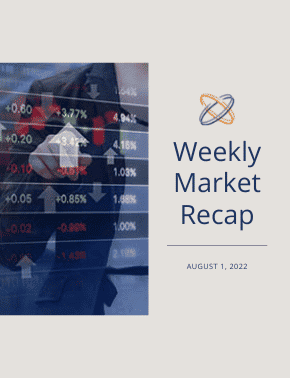Week in Review
Equity Markets:
The market had a strong rally last week despite more weakening data, with the S&P ending the week up over 4%. Last week was a perfect example of better or worse – it was neither good nor bad, with respect to data. Earnings season has been less than stellar when looking at the past decade and the second quarter of negative GDP. There has been a pessimistic aura over the market this year. This week’s earnings were better than expected, and parts of the economy were not as bad as expected. This is a recipe for positive market movement.
56% of S&P companies have reported so far and 73% have beat earnings expectations, according to FactSet. This is only slightly below the 5-year average and an increase from the 68% mark from last week. Also, the blended growth rate according to FactSet is 6%. The blended growth rate includes companies having already reported and the expected earnings from companies yet to report. This is certainly better than the 4% expected growth rate at the end of the second quarter.
Fixed Income Markets:
The highlight for the fixed income markets was the FOMC meeting where they raised the fed funds rate by 0.75%. This brings the Fed’s target rate to 2.25-2.5%. The bond markets reacted by driving yields down on the back of Fed Chairman Jerome Powell’s comments on the potential for slowing hikes in the future.
The 10-year treasury ended the week at 2.66%, down from its June high of nearly 3.5%. The bond market, along with equities, is viewing that the end of this rate hike cycle might be in sight.
Economic:
The second quarter GDP report dominated the majority of the headlines. The report showed that the US economy contracted by 0.9% in the quarter. Residential investment was the largest downside contributor to the negative reading, and the consumer softened relative to the previous quarter. This is the second consecutive quarter of negative GDP growth, and by many, this is a strong indicator of a recession. The National Bureau of Economic Research (NBER) is the one responsible for determining a recession. Negative GDP is not the only factor, and the NBER looks for broad economic weakness. The Labor market still remains strong and will likely need to weaken before a recession is declared.
Looking Ahead
Equity Markets:
The market is a discounting mechanism of future expectations. When expectations are overly negative, the results don’t have to be stellar. If results are better than expected the market tends to react positively. Earnings estimates have seen continued downgrades over the last few weeks and results came in better than expected.
The run-ups like we saw in the market last week are the main reason to stay disciplined as an investor. The market is quick to pivot and rarely foreseeable. Systematic rebalancing allows long-term investors the opportunity to take advantage of oversold assets that can see significant upside in a short amount of time. We are still recommending that investors stay disciplined and not take on excessive risk in light of softening earnings and economic numbers. As we have seen over the past couple of weeks, however, market upside can come out of times when the environment is dominated by pessimism.
Fixed Income Markets:
The FOMC has its policy meeting on Tuesday and Wednesday this week. Markets are anticipating the committee will raise rates, at a minimum, by 0.75%. After the higher-than-expected CPI reading a couple of weeks ago, the odds of a larger increase have risen. If a full percentage point increase takes place, it would be the largest rate hike since the Fed started using the overnight rate to conduct monetary policy, according to Bloomberg.
We still believe that the 10-year yield will spend the majority of its time in the 3.00-3.5% range over the next six to 12 months. This is due to the current inflationary environment and the actions the Fed will need to take to bring inflation down. As the Fed hikes rates, we continue to see yield curve flattening.
Economic:
ISM and S&P Global will report July Manufacturing and Services PMIs. Two labor market reports will likely be the top reports. We will see The JOLTS (Job Openings and Labor Turnover Survey) on Tuesday and ADP will release its national employment report on Wednesday.
Important Disclosures:
Investment Advisory Services offered through Krilogy®, an SEC Registered Investment Advisor. Please review all prospectuses and Krilogy’s Form ADV 2A carefully prior to investing. This is neither an offer to sell nor a solicitation of an offer to buy the securities described herein. An offering is made only by a prospectus to individuals who meet minimum suitability requirements.
All expressions of opinion are subject to change. This information is distributed for educational purposes only, and it is not to be construed as an offer, solicitation, recommendation, or endorsement of any particular security, products, or services.
Diversification does not eliminate the risk of market loss. Investments involve risk and unless otherwise stated, are not guaranteed. Investors should understand the risks involved of owning investments, including interest rate risk, credit risk and market risk. Investment risks include loss of principal and fluctuating value. There is no guarantee an investing strategy will be successful. Past performance is not a guarantee of future results. Indices are not available for direct investment; therefore, their performance does not reflect the expenses associated with the management of an actual portfolio. The S&P data is provided by Standard & Poor’s Index Services Group.
Services and products offered through Krilogy® are not insured and may lose value. Be sure to first consult with a qualified financial advisor and/or tax professional before implementing any strategy discussed herein.














